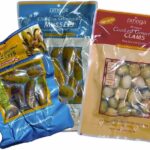Do you know the differences between Western and Eastern food? With such a wide variety of dishes and ingredients, it can be hard to know where one culture’s food begins and the other’s ends. In this article, we will explore the differences between Western and Eastern cooking, looking at the various ingredients and unique cooking styles that make each cuisine unique. From the readily-available ingredients of Western cooking to the exotic spices of Eastern cuisine, we will learn what makes each culture’s food so special. So, buckle up and get ready to explore the wonderful world of Western and Eastern cooking!
Western Cooking
When it comes to cooking, the Western world has developed a wide variety of techniques and recipes that are distinct from Eastern cooking. Western cuisine is composed of foods derived from a broad range of culinary influences, including French, Italian, German, British, and American influences.
Western cooking techniques are often characterized by the use of a greater variety of ingredients, heavy sauces, and manipulations of flavors. Common techniques used in Western cooking include roasting, grilling, boiling, stewing, blanching, frying, and baking. Common ingredients used in Western cooking include butter, cream, dairy products, garlic, herbs, spices, and wines.
Popular dishes found in Western food include steak and other proteins, mashed potatoes, casseroles, and pastas. Sauces such as béchamel, hollandaise, and béarnaise are commonly used for flavoring proteins, vegetables, and starches. Fruits are also a popular part of Western cuisine and can be used in many dishes.
When it comes to baking, the Western world has developed a wide variety of baking techniques such as cake and pastry making, bread baking, and cookies and pastries. Baking utilizes the same ingredients and techniques as other Western cooking, but there is an emphasis on precision, flavor, and decoration. Common ingredients used in baking include flour, sugar, butter, eggs, and flavors. Popular examples of desserts include cakes, pies, cookies, and pastries.
In conclusion, Western cuisine utilizes a wide variety of ingredients, flavors, and techniques when it comes to cooking and baking. From proteins to desserts, Western cooking is known for its diversity and creativity. The techniques used in Western cooking make it easy to create a wide variety of dishes with interesting flavors and textures.
Eastern Cooking
Eastern cooking has become incredibly popular in recent years, thanks to the explosion of international cuisine around the world. However, it is important to understand the differences between Eastern and Western food in order to appreciate these flavorful dishes. Eastern cooking, which includes cuisines from India, Japan, China, Thailand, and Korea, is characterized by its use of spices, seasonings, and techniques.
Eastern spices are usually more intense than those used in Western cooking. Spices such as ginger, garlic, cardamom, and turmeric are common and provide a deep and distinctive flavor to dishes. These spices can be combined in various ways to create traditional flavors, such as the popular masala blend used in Indian cuisine. Most Eastern spices come from the region, but some may also be imported from other countries, such as saffron from India.
In addition to spices, Eastern cooking also relies heavily on seasonings like soy sauce, fish sauce, and sesame oil. These seasonings impart a unique flavor to dishes and enhance their taste. Additionally, Eastern cooking often involves the use of unique techniques such as steaming, stir-frying, and deep-frying, which are not widely used in Western cooking.
Another important factor in Eastern cooking is the use of fresh ingredients. The majority of dishes use vegetables and fruits that are freshly picked or bought, and seafood that is freshly caught. The use of fresh ingredients ensures that dishes are packed with flavor and texture.
Finally, many Eastern dishes are served with various condiments and accompaniments, such as pickles, chutneys, and sambals. These condiments provide extra flavor to dishes and make them even more enjoyable.
Overall, Eastern cooking is incredibly flavorful and unique. Although many ingredients and techniques may be unfamiliar to Western cooks, with a bit of practice, Eastern dishes can be cooked with ease. By experimenting with spices, seasonings, and cooking techniques, cooks can create dishes that are both flavorful and delicious.
Conclusion
In conclusion, Western and Eastern cooking styles are unique with different ingredients and methods. Western cooking styles focus more on individual ingredients and experimenting with flavors while Eastern cooking styles emphasize contrasting flavors and balance of flavors. Both styles of cooking are essential to the culture and provide a unique experience and flavor to the food. Understanding the differences between these two styles of cooking is key to truly enjoying the unique flavors and experiences each provides.

 Guide to Choosing the Right Equipments for Singapore Commercial Kitchens
Guide to Choosing the Right Equipments for Singapore Commercial Kitchens  Steps to Reviving an Old-Fashioned Ice Cream Menu
Steps to Reviving an Old-Fashioned Ice Cream Menu  Opening Culinary Inventiveness: The Advantages of Business Kitchen Rental
Opening Culinary Inventiveness: The Advantages of Business Kitchen Rental  Harvesting Compassion: How Denver’s Food Donations Are Changing Lives?
Harvesting Compassion: How Denver’s Food Donations Are Changing Lives?  What Factors Should You Consider When Choosing a Sticker Manufacturer?
What Factors Should You Consider When Choosing a Sticker Manufacturer?  Where to Buy Dates Online: Discovering Quality and Convenience with Joolies
Where to Buy Dates Online: Discovering Quality and Convenience with Joolies  The science behind cold storage: preserving quality and freshness
The science behind cold storage: preserving quality and freshness  Signs Of a High-Quality Pizza
Signs Of a High-Quality Pizza  Exploring the Growing Market for Mussels Exports: Key Insights and Trends
Exploring the Growing Market for Mussels Exports: Key Insights and Trends 


